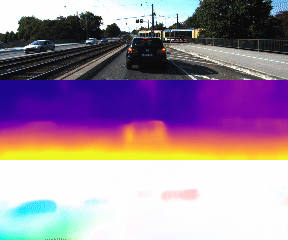vt-vl-lab / Df Net
Programming Languages
Labels
Projects that are alternatives of or similar to Df Net
DF-Net: Unsupervised Joint Learning of Depth and Flow using Cross-Task Consistency
A TensorFlow re-implementation for DF-Net: Unsupervised Joint Learning of Depth and Flow using Cross-Task Consistency. There are some minor differences from the model described in the paper:
- Model in the paper uses 2-frame as input, while this code uses 5-frame as input (you might use any odd numbers of frames as input, though you would need to tune the hyper-parameters)
- FlowNet in the paper is pre-trained on SYNTHIA, while this one is pre-trained on Cityscapes
Please see the project page for more details.

Prerequisites
This codebase was developed and tested with the following settings:
Python 3.6
TensorFlow 1.2.0 (this is the only supported version)
g++ 4.x (this is the only supported version)
CUDA 8.0
Unbuntu 14.04
4 Tesla K80 GPUs (w/ 12G memory each)
Some Python packages you might not have
pypng
opencv-python
Installation
- Clone this repository
git clone [email protected]:vt-vl-lab/DF-Net.git
cd DF-Net
- Prepare models and training data
chmod +x ./misc/prepare.sh
./misc/prepare.sh
NOTE: Frames belonging to KITTI2012/2015 train/test scenes have been excluded in the provided training set. Add these frames back to the training set would improve the performance of DepthNet.
Data preparation (for evaluation)
After accepting their license conditions, download KITTI raw, KITTI flow 2012, KITTI flow 2015.
Then you can make soft-link for them
cd dataset
mkdir KITTI
cd KITTI
ln -s /path/to/KITTI/raw raw
ln -s /path/to/KITTI/2012 flow2012
ln -s /path/to/KITTI/2015 flow2015
(Optional) You can add those KITTI2012/2015 frames back to the training set, by commenting line81~line85 in data/kitti/kitti_raw_loader.py, and do
python data/prepare_train_data.py --dataset_name='kitti_raw_eigen' --dump_root=/path/to/save/ --num_threads=4
Training
export CUDA_VISIBLE_DEVICES=0,1,2,3
python train_df.py --dataset_dir=/path/to/your/data --checkpoint_dir=/path/to/save/your/model
For the first time, custom CUDA operations for FlowNet will be compiled. If you have any compliation issues, please check core/UnFlow/src/e2eflow/ops.py
- Line31: specify your CUDA path
- Line32: Add
-I $CUDA_HOME/include, where$CUDA_HOMEis your CUDA directory - Line38: specify your g++ version
Testing
Test DepthNet on KITTI raw (You can use the validation set to selct the best model.)
python test_kitti_depth.py --dataset_dir=/path/to/your/data --output_dir=/path/to/save/your/prediction --ckpt_file=/path/to/your/ckpt --split="val or test"
python kitti_eval/eval_depth.py --pred_file=/path/to/your/prediction --split="val or test"
Test FlowNet on KITTI 2012 (Please use training set)
python test_flownet_2012.py --dataset_dir=/path/to/your/data --ckpt_file=/path/to/your/ckpt
Test FlowNet on KITTI 2015 (Please use training set)
python test_flownet_2015.py --dataset_dir=/path/to/your/data --ckpt_file=/path/to/your/ckpt
NOTE: For KITTI 2012/2015
- If you want to generate visualization colormap for training set, you can specify
output_dir - If you want to test on test set and upload it to KITTI server, you can specify
output_dirand test on test set.
Pre-trained model performance
You should get the following numbers if you use the pre-trained model pretrained/dfnet
DepthNet (KITTI raw test test)
| abs rel | sq rel | rms | log rms | a1 | a2 | a3 |
|---|---|---|---|---|---|---|
| 0.1452 | 1.2904 | 5.6115 | 0.2194 | 0.8114 | 0.9394 | 0.9767 |
FlowNet (KITTI 2012/2015 training set)
| KITTI 2012 EPE | KITTI 2015 EPE | KITTI 2015 F1 |
|---|---|---|
| 3.1052 | 7.4482 | 0.2695 |
Citation
If you find this code useful for your research, please consider citing the following paper:
@inproceedings{zou2018dfnet,
author = {Zou, Yuliang and Luo, Zelun and Huang, Jia-Bin},
title = {DF-Net: Unsupervised Joint Learning of Depth and Flow using Cross-Task Consistency},
booktitle = {European Conference on Computer Vision},
year = {2018}
}
Acknowledgement
Codes are heavily borrowed from several great work, including SfMLearner, monodepth, and UnFlow. We thank Shih-Yang Su for the code review.
